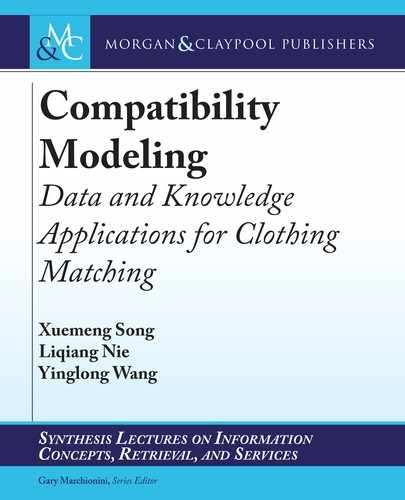
22 3. DATA-DRIVEN COMPATIBILITY MODELING
Table 3.1: Performance comparison of different approaches in terms of AUC
Approach AUC
POP 0.4206
RAND 0.5094
RAW 0.5494
IBR 0.6075
ExIBR 0.7033
BPR-DAE 0.7616
Table 3.2: Illustration of the most popular tops and bottoms
Rank 1 2 3 4 5
Top
Bottom
and bottoms, respectively. We noticed that the popular fashion items are all in the basic style,
such as plain T-shirts and jeans, which maybe due to the fact that they can go with many other
items. erefore, we can easily find the limitations of POP method. For example, most of the
popular bottoms are jeans, which maybe not suitable for professional tops and sport outfits.
erefore, it is not advisable to adopt recommendation strategy based on popularity. (2) ExIBR
and BPR-DAE both outperform the visual-based baseline IBR, which confirms the necessity
of considering the contextual modality in compatibility modeling. (3) BPR-DAE shows su-
periority over ExIBR. One possible explanation is that the highly sophisticated compatibility
space would be better characterized by the autoencoder neural networks rather than by the linear
transformation.
3.4.4 ON COMPONENT COMPARISON (RQ2)
To verify the effectiveness of each component of our model, we also compared BPR-DAE with
the following methods.
BPR-DAE-Norec: To check the component that regularizes the reconstruction error, we
removed the L
rec
by setting D 0.
..................Content has been hidden....................
You can't read the all page of ebook, please click here login for view all page.
